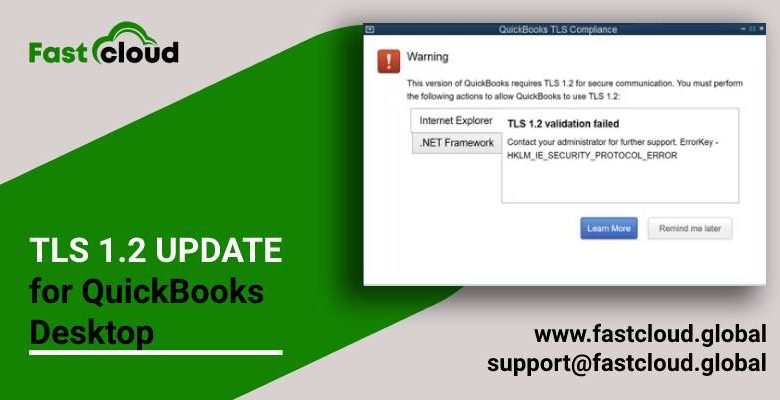How to Resolve QuickBooks TLS 1.2 Error? Step by Step Solution

QuickBooks is a dependable and well-respected accounting program that serves as a one-stop shop for all of your company’s accounting needs. Whether you’re a little business or a large corporation, QuickBooks provides a secure environment for you to upload large data. It does, however, have problems and errors, just like any other software. There are numerous faults and errors that might cause the software to freeze and cause issues with your operating system. A message appears on your desktop screen when an error occurs (QuickBooks not working or not responding).
You’ve probably heard of the TLS 1.2 error for QuickBooks desktop for Windows if you’re a QuickBooks user. When you encounter a TLS problem on your screen, it can only signify that QuickBooks Online Internet Explorer has been updated. Because to this problem, Internet Explorer TLS no longer supports QuickBooks online.
When it comes to running business, it’s critical that your security is top-notch. Sensitive and confidential information can be leaked as a result of a flaw in the code. As a result, QuickBooks TLS 1.2 is a powerful internet security protocol that aids in the protection of your secret and private information. TLS 1.2 for QuickBooks desktop for Windows will be discussed in this post. We’ll go through all you need to know about the TLS 1.2 problem and how to repair it.
What is QuickBooks TLS 1.2?
Before we go into how to fix the QuickBooks TLS 1.2 error, it’s important to understand what TLS 1.2 for Windows is. TLS stands for transport layer security and is a form of security protocol that aids in secure internet communication. Prior to the June 1, 2018 QuickBooks update, the effective security protocol for QuickBooks desktop was SSL/early TLS. The adjustment was made in order to comply with PCI data security rules. All of the connections utilized in the QuickBooks desktop have improved security and stability as a result of the upgrade. Following the upgrade, users will be able to quickly access Intuit services that are required to meet certain system requirements. If your software gives you a TLS 1.2 error, it signifies that some of your system requirements aren’t being met.
If you’re not sure what the following prerequisites are, check out the TLS 1.2 Readiness tool. Users will be able to utilize the Readiness tool to update their systems so that TLS 1.2 is compatible with all Windows operating systems, Internet Explorer, and.NET requirements.
For Windows users, the following are the system requirements:
- If you’re using Internet Explorer in Windows 10 or 11, make sure to verify whether IE TLS 1.2 is enabled by default.
- If you’re using IE 8 or Windows XP/Vista, make sure you update your OS to the newest version to acquire IE 11, then your desktop will be able to use TLS 1.2.
- For users of Windows 7/8/8.1 and Internet Explorer 9/10: TLS 1.2 is not supported by default in Internet Explorer 9 or 10. To activate TLS 1.2, you must update your Internet Explorer to the most recent version.
SSL/Early TSL or TLS 1.2
If you’re having trouble deciding if TLS 1.2 or SSL/Early TSL is better for your QuickBooks, consider the following:
TLS 1.2 is undeniably a superior system security protocol. Netscape was the first to introduce SSL in 1990. However, both the SSL and early TLS protocols have some flaws. Hackers can easily gain access to your machine through these flaws. If you do not upgrade your SSL in a timely manner, these problems will continue to occur.
TLS, on the other hand, has seen a slew of improvements that have boosted its performance to new heights. More support for new cryptographic methods has been added by the developers. As a result, TLS 1.2 has gained popularity with QuickBooks users. If you use QuickBooks desktop, you should consider updating to TLS 1.2 as well.
Symptoms of QuickBooks TLS 1.2 Error:
Many problems can arise if you don’t update your QuickBooks desktop to TLS 1.2. Intuit launched a new security protocol on May 31, 2018 to ensure that all QuickBooks connections meet all of the relevant requirements. This can improve the security and confidentiality of all of your QuickBooks data. If your software does not meet all of the standards, however, you may face certain disadvantages. TLS 1.2 faults can be identified in the following ways.
- Online payroll, payments, online banking, and other payment systems may become unavailable.
- If you’re trying to install QuickBooks on a new computer, things might not go as planned.
- The password reset function won’t work anymore.
- My apps, protected webmail, contributed reports, and other Intuit account credentials services will be affected as well.
- Intuit Data Protect will be turned off.
- VAT e-filing and help pages
- Checks and materials will no longer be available for purchase.
System requirements for QuickBooks TLS 1.2
It’s critical to comprehend TLS 1.2’s system requirements. When implementing TLS 1.2 with QuickBooks for Windows without the required requirements, you may run into a lot of problems. As a result, you must ensure that your software and operating system are up to date and that you have all of the basic prerequisites for TLS to function effectively. The following is a list of all TLS 1.2 system requirements:
How can I fix QuickBooks Desktop’s TLS 1.2 Update Error?
The TLS 1.2 problem, like every other error in QuickBooks, may be fixed with a few simple clicks. The following are some suggestions for avoiding TLS 1.2 issues with QuickBooks.
- The most recent version of QuickBooks desktop is required. If not, make sure you download and install the most recent version.
- In addition, you must use the Intuits TLS 1.2 readiness tool in the most recent version of QuickBooks. You may check whether your system is ready for the security layer this way.
- If the tool indicates that your system isn’t ready, you’ll need to make all of the necessary adjustments.
- Also, make sure you have the most recent version of Internet Explorer.
- To have the greatest Internet Security settings, run QuickBooks as an administrator and allow everyone access and privileges.
The following steps can help you resolve TLS 1.2 update issues in QuickBooks:
Solution 1: Use the TLS 1.2 Readiness tool.
Run the QuickBooks readiness tool by going to QuickBooks readiness tool. After that, make sure your operating system is up to current and capable of supporting TLS 1.2. There are two steps to this solution, which are outlined below:
Step 1: Get the QuickBooks Tool Hub and install it.
- First close your QuickBooks software.
- Then, for the current version of QuickBooks Tool Hub, which is 1.5.0.0, download it.
- It should save to your system disc, where you can find it.
- Run exe from the downloaded folder.
- Install it by following the on-screen instructions.
- After the process is complete, launch the tool hub by double-clicking the icon on your Windows desktop.
Step 2: Open the tool hub and run the TLS 1.2 utility.
- Select the Installation Issues option from the QuickBooks Tool Hub.
- Then, in the lower right corner of the screen, select QuickBooks TLS 1.2 Tool.
- Open the TLS Tool by pressing the OK button.
- Accept the EULA Agreement by clicking yes.
- After that, start the software and wait for it to finish.
- When it’s finished, click the tool hub’s exit button.
That’s all there is to it. If this procedure fails to resolve the TLS 1.2 problem, try one of the other options listed below.
Solution 2: Set the TLS security settings in Internet Explorer.
When migrating from QuickBooks Online to QuickBooks Desktop, the TLS issue can occur. In such circumstances, you can resolve the problem by following the methods outlined below.
- Select Tools, then Internet Options from the drop-down menu.
- From the General tab, select Delete.
- After that, go to Temporary Internet Files > Delete.
- Select Tools, then Internet Options from the drop-down menu.
- From the General tab, select Delete. Select Temporary Internet Files > Delete after that. However, do not click the option to remove cookies.
- Now, under the Connections tab > LAN settings, navigate to the LAN settings.
- Ensure that the box labelled “Automatically Detect Settings” is selected.
- If you aren’t utilizing any proxy servers, leave these blank.
- Now, follow the directions on the screen and click OK twice.
- Go to the advanced options page.
- Begin scrolling down the page to see if both SSL 2.0 and SSL 3.0 are marked.
- If they’ve marked, remove them.
- Carry out the same procedure with the TLS 1.2 box.
Return to your QuickBooks software after closing the settings. If this solution does not work for you, try the next one down below.
Solution 3: Download and install the TLS 1.2 security update.
Only the QuickBooks Desktop Point of Sale is supported by this approach. You can use this way to address your problem if you have QuickBooks Desktop Point of Sale and Windows 7 or higher.
- Go to the ‘Help’ section of the menu.
- Select ‘Software Updates’ from the drop-down menu.
- Select ‘Check for Updates’ from the drop-down menu.
- If an update is available, click it to get the most recent version.
Conclusion
That’s all there is to it. We tried to cover all of the important features and elements of the TLS 1.2 QuickBooks problem. To correct the error, use the techniques listed above. If the problem persists after completing all of these steps, please contact any IT professionals or QuickBooks customer service.




